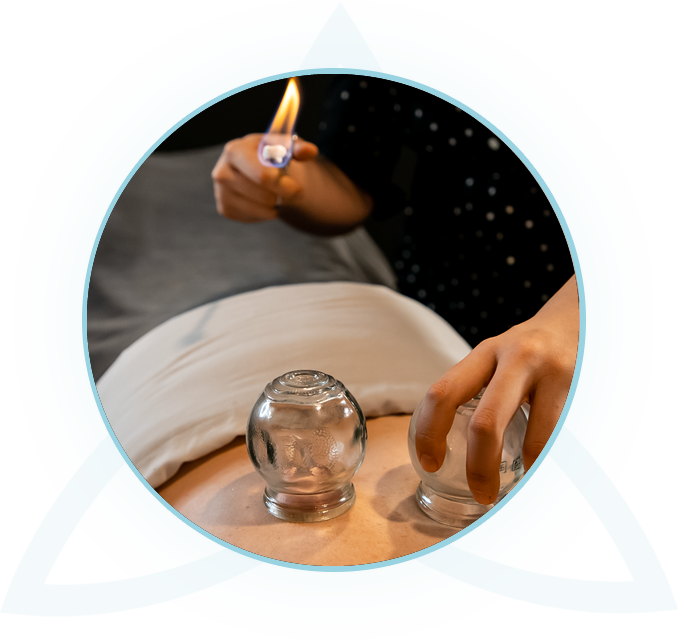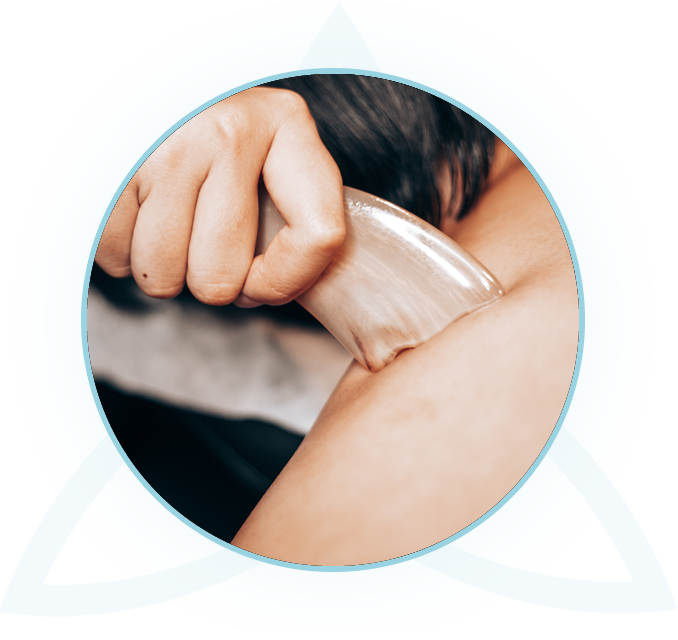

Cupping massage involves placing special cups filled with heated air on painful areas of the body. As the cups cool, the volume of air within them shrinks, creating suction on the skin that increases blood flow to the area. If oil has been applied, the cups can be moved around the patient’s body along the “meridians” and at the specific points, which is called “cupping massage therapy”. As the combination of massage movements and negative pressure, cupping massage is considered one of the best deep tissue therapies available. Cupping massage is the inverse of typical massage-rather than applying pressure to muscles, it used gentle pressure to pull them upward. This is a particularly relaxing and relieving sensation.
In Traditional Chinese Medicine (TCM) theory, it is believed that Qi (the universal life force energy) flows throughout our bodies in channels called meridians. Any misdirection, blockage, or other derangement of the amount, flow, or balance of Qi may result in pain, dysfunction and illness. When the Qi is blocked at certain points, or when Qi needs to be drawn to the surface of the body from deep within, cupping massage is used to disperse and move Qi by exerting suction and pressure. It has been shown to affect tissues up to four inches deep from the external skin. Toxins are released, blockages are cleared, and veins and arteries can be refreshed within these four inches of affected materials.

Cupping is great for pain, particularly pain related to lack of blood flow and stagnation that is cold and damp in nature.Cupping massage is effective in softening tight muscles and tone attachments, loosening adhesions, lifting connective tissue, bringing hydration and blood flow to body tissues, draining excess fluids and toxins by opening lymphatic pathways and stimulating the peripheral nervous system. It is used to alleviate the pain and discomfort arising from disorders of the joints, lungs and other internal organs, muscle spasms, and numerous other conditions. In modern times, cupping massage is known as an effective, simple, non-invasive, inexpensive, and safe form of treatment that can be used by itself or in combination with other forms of therapeutic approaches.
Gua Sha is an ancient healing technique used in traditional Chinese medicine.
It is practiced to relieve the stagnation of blood that obstructs surface tissues and inhibits organ function. The meaning of the Chinese character “Gua” means to rub or to scrape while the second character “Sha” is a reddish and raised area of skin. Literally in Chinese "Gua Sha" means to scrape away fever.
In the treatment, special oil is put on a particular area of the skin whereafter the therapist starts "scraping" the area repeatedly with a "scraper" (a specially designed instrument of jade or horn).
Patients hardly feel pain, neither during nor after the treatment. The skin will not be damaged, and the red spots will fully disappear within 3 to 7 days. In most cases the patient feels an immediate improvement in their condition particularly in their pain or sense of constraint.

The color of sha varies according to the severity of the patient’s blood stasis, which may correlate with the nature, severity and type of their disorders. It may appear from purple or black, dark red to a light pink, but is most often a shade of red. Although the marks on the skin look painful, they are not.
Gua Sha helps to move stuck Qi and blood, release the exterior sweating and move fluids. In modern medicine, these fluids are known to contain metabolic wastes that congest the surface tissues and muscles. Gua sha allows for the movement of metabolic waste, promotes circulation and normalizes metabolic processes. It is particularly effective in relieving body pain from headaches to shoulder, neck, back and joint pains as well as nerve pains, PMS, rheumatism and osteoporosis. Gua Sha is also helpful in the treatment of diseases that are brought about by functional imbalance of an internal organ.
Herbal medicine, also called botanical medicine or phytomedicine, refers to using a plant's seeds, berries, roots, leaves, bark, or flowers for medicinal purposes. As an essential part of Traditional Chinese Medicine (TCM), Chinese Herbal Medicine is one of the great herbal systems of the world, with an unbroken tradition which can be traced back to the 3rd century BC. It has been used for centuries in China, where herbs are considered fundamental therapy for many acute and chronic conditions. Herbs can be used together with other remedies, such as acupuncture, to benefit the clinical outcomes and to provide long lasting relief.
Yet throughout its history it has continually developed in response to changing clinical conditions, and has been sustained by research into every aspect of its use. This process continues today with the development of modern medical diagnostic techniques and knowledge.
Chinese pharmacologist Tu Youyou received the Nobel Prize in Physiology or Medicine 2015, for using traditional Chinese herbal medicine to find a new kind of antimalarial agent.
Today, there are more than 450 substances commonly used in Chinese herbal medicine. Most are of plant origin, such as roots, bark, seeds, fruit, branches and leaves, though some animal and mineral substances may also be used.Thousands of these herbs are available to suppliers of traditional Chinese remedies.
Today, there are more than 450 substances commonly used in Chinese herbal medicine. Most are of plant origin, such as roots, bark, seeds, fruit, branches and leaves, though some animal and mineral substances may also be used.Thousands of these herbs are available to suppliers of traditional Chinese remedies.
Chinese herbal medicines are prescribed either singly or made into formula which takes into account the individual therapeutic action of each herb and well as the effects when combined together. Traditional Chinese Medicine formulas usually combineeight to 12 herbs and may be prescribed in pill or extract form or as dried herbs to make a tea. A well-constructed formula maximizes the effectiveness for treating a particular condition, while counteracting and minimizing the unwanted effects of an individual herb. It makes it possible to treat multiple conditions at the same time
Many internal disharmonies or chronic conditions, including metabolic diseases, chronic and degenerative conditions age-related diseases, allergy and asthma, can greatly benefit from the use of herbal medicine, especially those which modern Western doctors have no pharmaceutical drugs for. Chinese herbal medicine seeks primarily to correct internal imbalances rather than to treat symptoms alone, and therapeutic intervention is designed to encourage this self-healing process. In addition to providing effective treatment for a wide range of health disorders, Chinese herbal medicine may also be used to assist with general health maintenance and disease prevention. By strengthening and enhancing normal body functions, the immune system is boosted and a general sense of well-being promoted.